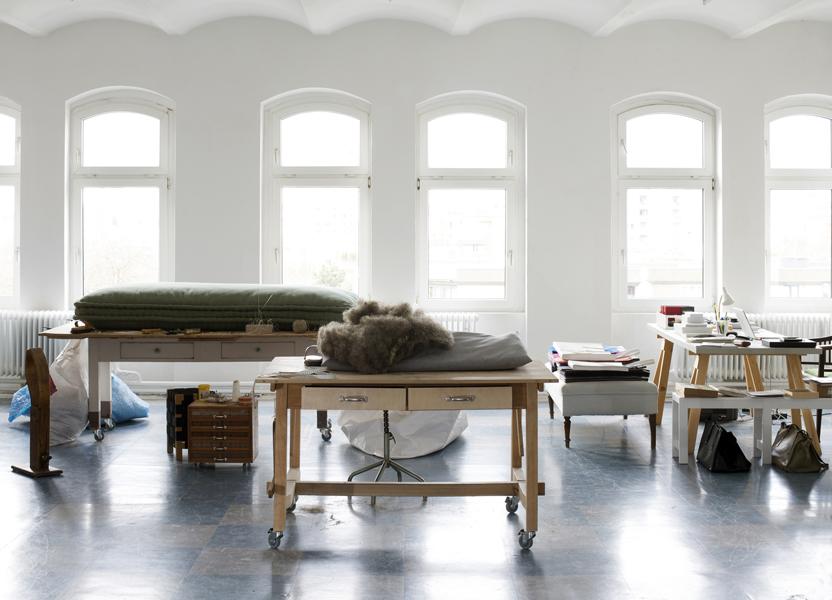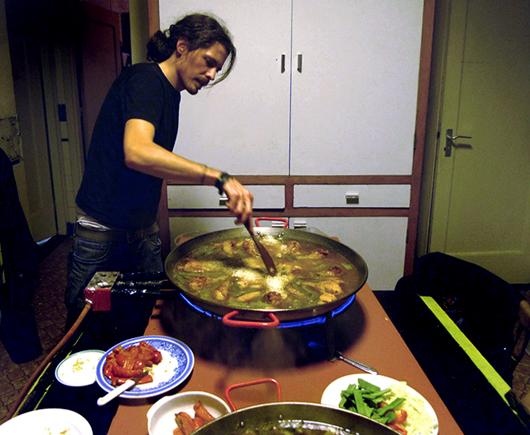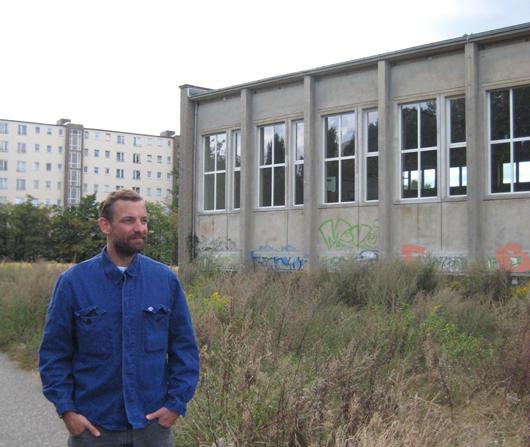
05.07.10
An Afternoon With
Finding Utopia in Kreuzberg with Designer Jerszy Seymour
Last summer I spent the month of June living and working in Berlin, which is also the home base of the designer Jerszy Seymour. Right-hand man to Vitra and Magis and inventor of the amorphous conceptual building material Scum, he’d just had his busiest year ever — mounting five exhibitions on his way to being guest of honor at the Design Parade festival in Hyères, France, with a monograph to follow. Having already known him from previous projects, I convinced him to spend the day with me discussing his Coalition of Amateurs project, the subject of all those shows; he offered to take me to Nowhere Land, which turned out to be an overgrown meadow just north of the hipster enclave Kreuzberg.
So why did it take me so long to post this story? Source Book came out in August of last year; our site launched in November. But I sat paralyzed, unsure of how to parse Seymour’s abstract, metaphor-laced musings for an actual audience. This is a man who appended his monograph with a reading list, after all (it’s copied at the end of this post). In the end, I’m publishing his words pretty much as they were spoken, as a small glimpse into the thought process of one of the most intriguing design minds working today.
JS: The reason why I thought to come here is because this is a nowhere place, and the nowhere place has always been about utopia — it means ‘nowhere place,’ or ‘no place,’ from the Greek. When they talked about the no place then, it was in an abstract modernist sense, where this no-place was invented. But here we’re actually in a city where you see the end of modernism, at the meeting point of capitalism and of communism, and in the middle there’s the no-place to start something again. And this no-place is not an abstraction, it’s real and it’s actually in the center of the city in front of everyone’s faces. That’s why I suggested coming here, because the actual no-place is the every-place. Foucoult talked about the heterotopia, which is the other-place, and the importance of other-places. But what in fact is interesting is the every-place, and you’ll find it in every city. And that’s the place of opportunity.
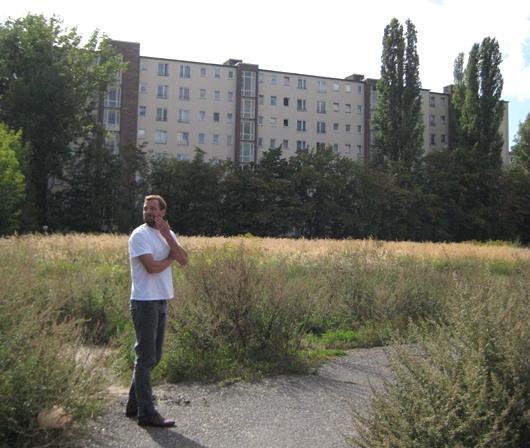
MK: Except that empty urban spaces always carry the implication that eventually there will be a commercial building, at least in America. It means someone’s about to put condos up.
JS: And give it five years and I have no doubt that that will happen here, but what I mean by it is that those no-places are opportunities while they’re still empty. And we can make those spaces as well, or find them in a corner. The point is that this place here came by a certain poetic tragedy of the Western world — the end of WWII, the bringing of the U.S. into world politics, the beginning of the Cold War, the clash of two ideologies. What more tragedy do you want? And this was in the middle of it. I think Hitler’s bunker was somewhere down there, the blockade. And to think this hasn’t been touched since the second World War. It makes it really one of the most special spots in Berlin. These people who live here, the wall was right in front of them, on the other side of those trees. Where there wasn’t the river, there was always two walls and a space in between which was mined. This grass here was the space between. If you keep going along here you get to Potsdamer Platz. And this is now the center of hip Berlin. Mitte is there, and Kreutzberg is there. I cycle through here quite a lot.
MK: Is it inspiring to you somehow?
JS: Yeah, somehow. No-man’s land is perfect for a nowhere person. I might have a Canadian passport, but I’m not Canadian, and I’m not English, and I’m not German, so what the fuck am I? So this is a really great place for me. I think that’s really right.
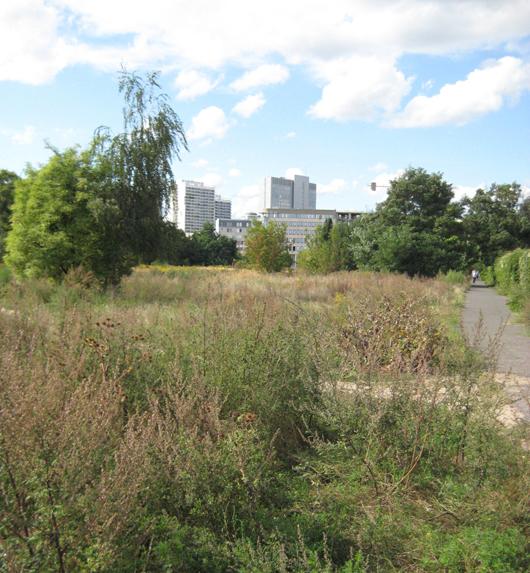
MK: But you also were telling me before how you flew 52 times last year, and the airplane is the best nowhere place there is.
JS: But I wouldn’t push that forward as my concept, because that was just the symptom of a bad year. This year I really moved everything to spend longer in each place. And I like the idea of turning the amateurs project into a van trip. I talked to you about wanting to call my book a flow book rather than Source Book, and it has to do with that. I’m interested in the moment of being on the road. So maybe flow is much nicer than source, because I’m not interested in telling people what to do or that there’s one single truth. The book does talk about the volcano as a source, and everybody being volcanoes — emotional beings — and includes a text from the Serbian philosopher Slavoj Žižek, who wrote about something called the orgasm of forces. At the beginning, everything is just like [explosion sound] and the decision just to be. After that, everything else is a secondary decision. To say that we’re all volcanoes is a bit to realize that people are erupted emotional things, and I don’t start with some idea of what’s right and wrong but with the idea that the human being is a very complex animal.
So my book starts with a number of sources talking about volcanoes, and pictures of different emotions. It goes on to talking about how the workshop functions. It’s a place for a group of people to try things out, so we give examples of that, like a photo of Stephan and Mendel trying to pile beer bottles up as high as possible. And there are pictures of groups of people doing things together, like one of us at the pre-opening of the Marta Herford show, when we stole a forklift truck in the middle of the night, completely drunk, and posed in front of all the exhibits naked. And another with everyone trying to create a human pyramid up to this huge metal ball sculpture in the street. This is all part of thinking and planning. After that it actually goes into being, doing, and sharing, which are the three amateur functions and which create the context for all of our discussions. If you look at dealing with a society, then production, economy, energy, distribution, communication — these are all the things that have to be looked after to create a functioning system, but you take those and superimpose being, doing, and sharing on top.
Read a book from one of the Situationists International, The Revolution of Everyday Life. It was written in 1967 by Raoul Vaneigem, who’s into all these models of participation, how people can have their individuality but also have participation, even communication and love. Communication is actually in a way love, because love is about connecting to other people. Communion, Christ’s communion, Communism — it’s just about togetherness, really. I’m making all these associations with words, but they become really important. We’re talking about life, we’re in the middle of no man’s land…
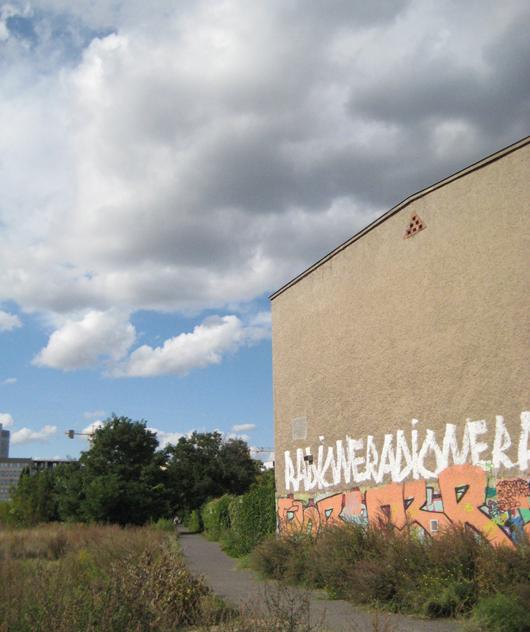
MK: Talking about loving and sharing…
JS: Exactly, yeah. This place is maybe enough, though. It’s actually quite peaceful. I wouldn’t mind having a house in the middle of this, or even a cabin or a tent. The great no-man’s lands really are the places where nature is king, somehow. I’m sure being on top of a mountain is really no-man’s land. Even if a country owns it, once you’re up there I think it’s really nature that’s more in charge. With the Scum project, there was a drawing that was never more than a sketch on a piece of paper, which was about how the project would take over all of the no-man’s lands and create a kind of seam between all the lands, then dissolve itself so there would be no more borders. I’m absolutely against the existence of nations. In the amateur declaration of rights, there is one part of the diagram that begins to address that: no frontiers, and equal or equivalent human rights. If we want to talk about design and how to deal with that situation, there also has to be the understanding that if we have a Western economy that’s run on the slave labor of the Chinese, of a third-world situation, it’s immoral. At a certain point, everyone should be able to go everywhere. Sometimes I think, yeah sustainability’s okay, but take care of what we consume or it’s not sustainability. You don’t make a product sustainable, you just stop the consuming part. Fuck being green.
- Aesthetics and politics, Adorno et al, 1977
- Being and nothingness, Jean-Paul Sartre, 1943
- Capital, Karl Marx
- Civil disobedience and other essays, Henry David Thoreau, 1849
- Du contrat social, Jean-Jacques Rousseau, 1750
- Freedom versus organization 1776-1914, Bertrand Russell
- Madness an Civilisation, Michel Foucault, 1964
- News from nowhere, William Morris, 1890
- Principles of political economy, John Stuart Mill
- Siddhartha, Hermann Hesse, 1951
- Society of spectacle, Guy Debord
- The communist manifesto, Karl Marx and Friedrich Engels, 1888
- The craftman, Richard Sennett, 2008
- The great explosion, Eric Frank Russell, 1962
- The revolution of everyday life, Raoul Vaneigem, 1983
- The self-overcoming of nihilism, Nishitani Keiji, 1990
- Utopia deferred, Jean Baudrillard, 2001
- Utopia, Thomas More, 1965

